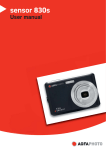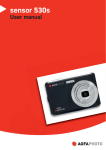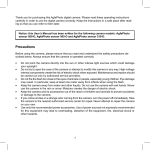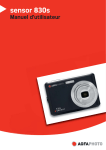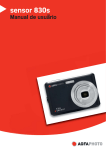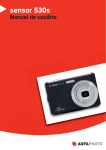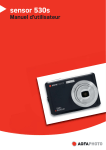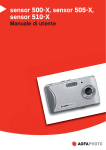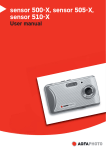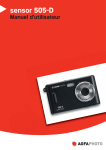Download AgfaPhoto Sensor 830s, Black
Transcript
Thank you for purchasing this AgfaPhoto digital camera. Please read these operating instructions carefully in order to use the digital camera correctly. Keep the instructions in a safe place after reading so that you can refer to them later. Precautions • • • • • • • Do not point the camera directly into the sun or other intense light sources which could damage your eyesight. Do not try to open the casing of the camera or attempt to modify this camera in any way. High-voltage internal components create the risk of electric shock when exposed. Maintenance and repairs should be carried out only by authorized service providers. Do not fire the flash too close to the eyes of animals or young children. Eye damage may result. Please remain at least one meter away from infants when using the flash. Keep the camera away from water and other liquids. Do not use the camera with wet hands. Never use the camera in the rain or snow. Internal moisture is dangerous and may lead to electric shock. Keep the camera and its accessories out of the reach of children and animals to prevent accidents or damage to the camera. If you notice smoke or a strange odor coming from the camera, turn the power off immediately. Take the camera to the nearest authorized service center for repair. Never attempt to repair the camera yourself. Use only the recommended power accessories. Use of power sources not expressly recommended for this equipment may lead to overheating, distortion of the equipment, fire, electrical shock or other hazards. Disclaimer We assume no responsibility over and above the provisions of the Product Liability Law for damages suffered by the user or third parties as a result of the inappropriate handling of the product or its accessories, or by their operational failure and by their use. We reserve the right to make changes to this product and its accessories without prior notice. Warning! Never open the camera or remove any parts of it. This will void all warranty claims. Using your batteries For best performance and prolonged battery life, we recommend the use of rechargeable NiMH batteries. Extending battery life Excessive use of the following functions use up a great deal of battery power and should therefore only be used occasionally: • Flash • Editing images on the camera display The battery life can be affected by soiling. Please clean the contacts with a clean, dry cloth before putting the batteries in the camera. Battery performance drops at temperatures below 0° C. If you use the camera at low temperatures you should have replacement batteries to hand and ensure they do not get too cold. Please note: you should not dispose of cold and seemingly flat batteries because these batteries may work again at room temperature. 1 1. Table of Contents Backlight Mode........................................ 16 Candle Light Mode .................................. 16 Auction Mode .......................................... 17 Precautions.............................................. 1 Disclaimer.................................................. 1 Warning! .................................................... 1 Using your batteries .................................. 1 Extending battery life................................. 1 6. Menu Mode ....................................... 18 Mode Set ................................................. 18 Image Size (Default: 8M)......................... 18 Metering (Default: Multi) .......................... 18 Sharpness (Default: Normal)................... 18 Quality (Default: FINE) ............................ 18 Shooting (Continuous) (Default: Single).. 18 Effect (Default: Normal)........................... 19 OSD Information (Default: Detail)............ 19 Face Detection (Default: On)................... 19 1. Table of Contents .............................. 2 2. General Introduction ......................... 3 Package Contents ..................................... 3 External View ............................................ 3 Display Information.................................... 5 3. Getting Started................................... 7 Turning Power On & Off ............................ 7 Inserting / Removing the Batteries ............ 7 Inserting /Removing a Memory Card......... 8 Attaching the Wrist Strap........................... 8 7. Movie Clip Mode .............................. 20 Size 20 Metering .................................................. 20 Multi Metering:......................................... 20 Spot Metering: ......................................... 20 Effect 20 OSD Information...................................... 20 4. Buttons & Functions ......................... 9 Turning Power On & Off ............................ 9 Shutter....................................................... 9 Tele / Wide ................................................ 9 Playback.................................................. 10 Mode 10 Basic Operations ..................................... 10 EV............................................................ 10 ISO .......................................................... 11 WB........................................................... 11 Menu 12 Up / Play & Pause / Macro ...................... 12 Right / Flash ............................................ 12 Down / Voice Memo ................................ 12 Left / Self-timer ........................................ 13 8. Voice Recording Mode .................... 21 9. Playback Mode................................. 22 Protect ..................................................... 22 Slide 22 Delete ...................................................... 23 DPOF ...................................................... 23 Copy To Card .......................................... 23 Resize ..................................................... 24 Rotate...................................................... 24 Effect 24 10. Set Up Mode ..................................... 25 5. Still Image Mode .............................. 14 Capturing Images .................................... 14 Mode Set ................................................. 14 Auto Mode ............................................... 14 Program Mode......................................... 15 Portrait Mode........................................... 15 Night Portrait Mode ................................. 15 Sunset Mode ........................................... 15 Fireworks Mode....................................... 15 Beach Mode ............................................ 16 Landscape Mode..................................... 16 Night Landscape Mode ........................... 16 11. PC Connection ................................. 27 12. Specifications .................................. 28 13. Customer care.................................. 30 Customer care......................................... 30 Disposal of Waste Equipment by Users in Private Households in the European Union ....................................................... 31 FCC Compliance and Advisory ............... 31 2 2. General Introduction Package Contents AgfaPhoto Sensor 830s Camera Driver & Software CD Quick Guide Wrist Strap Camera Pouch 2xAA Batteries External View Top Microphone Shutter Button Strap Eyelet Power Button 3 USB Cable Side USB Connector Battery/Memory Card/Compartment Cover Front LED Flash Lens Back Wide/Tele Button LCD Monitor Tripod Socket 4 Wide/Tele Button Playback Button Mode Button Delete/Exposure Button Play/Pause/Up Button Flash/Right Button Self-Timer/Left Button Voice Memo/Down Button Menu Button Display Information 1. Operation Mode ( ) Auto ( ) Program ( ) Portrait ( ) Landscape ( ) Night Portrait ( ) Night Landscape ( ) Sunset ( ) Backlight ) Fireworks ( ( ( ( ( ( ) Candle Light ) Beach ) Auction ) Movie Clip Mode ) Voice Recording Mode 2. Battery Status ( ) Batteries Full ( ) Batteries Half Full ( ) Batteries Empty 5 3. Shooting Mode ( ) Single ( ) Continuous 12. W. Balance ) Auto ( ) Daylight ( ) Cloudy ( ( ) Sunset ( ) Fluorescent ) Tungsten ( ) Custom ( 4. Flash Mode ( ( ) Auto Flash ) Red-Eye ( ) Fill-in Flash ( ) Slow Sync ( ) Flash Off 13. Sharpness ( ) Soft ( ) Normal ( ) Vivid 5. Self-timer ( ) 10 Seconds ( ) 2 Seconds ( ) Double 14. Quality ( ) Super Fine ) Fine ( ( ) Normal 6. Focus Range ( ) Macro 15. Image Size Still Image (8M) 3264 x 2448 (5M) 2592 x 1944 (3M) 2048 x 1536 (1M) 1280 x 960 Movie Clip (720) 720 x 480 (640) 640 x 480 (320) 320 x 240 7. Metering ( ) Multi ( ) Spot 8. Memory Status ( ) Memory Card Inserted 9. Time & Date 10. ( ) Exposure ± 2EV 0.5 EV Steps 16. Estimated Available Shots & Video Time 11. ISO Value 17. F No. & Shutter Speed ( ) Auto ( ) 100 ( ) 200 ( ) 400 ( ) 800 18. Zoom Status Indicator 19. ( 6 ) Face Detection 3. Getting Started Turning Power On & Off • • Press the Power Button to turn the camera on. Press the Power Button again to turn the camera off. Inserting / Removing the Batteries 1. 2. 3. Power off the camera. Slide open the battery compartment cover. Remove the batteries or, respecting the polarity indications, insert them. 4. Close the battery cover. 5. Battery status indicator. ( ): Batteries full. ( ): Batteries half full. ( ): Batteries empty. Replace with new batteries. • • The batteries will discharge if kept inside the camera for a long time without use. Remove the batteries when the camera is not in use. The batteries may not work normally under 0oC or over 40oC. 7 Inserting /Removing a Memory Card 1. 2. 3. 4. 5. Power off the camera. Open the battery compartment cover. Insert the memory card into the card slot and press it gently until you hear a click. To remove, gently press on the edge of the card and pull it out. Close the battery cover. Attaching the Wrist Strap 8 4. Buttons & Functions Turning Power On & Off • • Press the Power Button to turn the camera on. Press the Power Button again to turn the camera off. Power • If the camera is left idle for a certain period of time, the camera will power off automatically. Shutter Shutter • Press the shutter button half way to focus and then press it fully down to capture an image. Tele / Wide • • • Press the Tele Button. The Zoom Bar Indicator will appear in the top of the LCD display showing the current zoom status. Press the Wide Button. The Zoom Bar Indicator will return to the Wide view. The camera allows maximum 3.0x optical zoom and 5.0x digital zoom. 9 Playback • • • • • You can use the playback mode to replay, delete or edit images on the LCD. Select the Playback Mode by pressing the Playback Button ( ). Playback Mode displays still images, movie clips and voice recordings. Select an image by pressing the Left or Right Button. Press and hold the Left or Right Button to fast forward the images. Mode Still Image Movie Clip Voice Recording Basic Operations • To adjust white balance and ISO select Program Mode ( ). EV • • • • • To adjust the EV value, press the Delete / Exposure Button ( ). Press Left / Right Button to set the Exposure Value. You can adjust from -2.0EV to +2.0EV (in 0.5EV steps). After the preferred value has been selected press the Menu Button to confirm the setting. The higher the EV value, the brighter the image will be. 10 ISO • To adjust the ISO value, select Program Mode and press the Delete / Exposure Button • • ( ). Press the up or down button to toggle between EV, ISO and white balance. Press the Right / Left Button to set the ISO value and press the Menu Button to confirm. WB • To adjust the WB value, select Program Mode and press the Delete / Exposure Button • • ( ). Press the up or down button to toggle between EV, ISO and white balance. Press the Right / Left Button to set the WB value and press the Menu Button to confirm. Auto Adjusts the white balance automatically Daylight For bright light conditions Cloudy For cloudy conditions Sunset For sunsets/twilight conditions Fluorescent For florescent light Tungsten For tungsten light Custom Under lighting conditions different from the above ones 11 Menu • • Press the Menu Button open the menu. When the menu appears on the LCD display, the Menu Button is used to move through the highlighted items in the submenu or to select a menu item. Up / Play & Pause / Macro • • • Press the Up Button ( ) to move up the submenu. ) operates as When the menu is not displayed on the LCD display, the Up Button ( the Macro function. The Up Button also operates as the Play & Pause function to play voice recordings & movie clips in Playback Mode. Right / Flash • Press the Right Button ( • The Right Button ( ) to highlight items in the right tab. ) also operates as the Flash function. Down / Voice Memo • • Press the Voice Button ( ) to highlight items in the down tab. There are two ways you can add your voice to a stored still image. 1. Shooting Mode 2. Playback Mode 12 Left / Self-timer • Press the Left Button to highlight items in the left tab. 10 sec. Self-timer ( ): The image will be taken 10 seconds after the shutter is released. 2 sec. Self-timer ( released. ): The image will be taken 2 seconds after the shutter is With the Double Self-timer ( ): The first image will be taken after 10 seconds. The second image will be taken a few seconds after the first shot. Two pictures will be taken once the shutter is released. 13 5. Still Image Mode Capturing Images Taking a Picture 1. Press Power Button to power on the camera. 2. Press the Shutter Button half way to focus. 3. Press Shutter Button fully to capture the image. • Using the Zoom Press T or W on the Zoom Button It is recommended that you take photos with the camera mounted on a tripod or other device if the Shaking Hand ( ) icon appears. Mode Set Auto Mode In this mode the following settings will be automatically locked at the factory default settings and cannot be adjusted. (a) (b) (c) (d) (e) Metering: Multi Sharpness: Normal Effect: Normal Shooting (Continuous Shooting): Single Available Flash modes: (1) Auto Flash (2) Red-eye Reduction (3) Flash Off 14 Program Mode After the above procedure, you can press the Menu Button again to configure your own settings for the image. In Program Mode, metering, sharpness, effect, white balance, shooting flash & ISO can be adjusted. Portrait Mode In this mode the settings will be locked as indicated below: (a) Metering: Multi (b) Sharpness: Normal (c) Shooting (Continuous Shooting): Single (d) Available Flash modes: (1) Auto Flash (2) Red-eye Reduction (3) Flash Off Night Portrait Mode In this mode the settings will be locked as indicated below: (a) Metering: Multi (b) Sharpness: Normal (c) Effect: Normal (d) Shooting (Continuous Shooting): Single (e) Available Flash modes: (1) Auto Flash (2) Red-eye Reduction (3) Fill-in Flash (4) Slow Sync (5) Flash off Sunset Mode In this mode the settings will be locked as indicated below: (a) Metering: Multi (b) Sharpness: Normal (c) Effect: Normal (d) White Balance: Daylight (e) Shooting (Continuous Shooting): Single (f) Flash: Off Fireworks Mode In this mode the settings will be locked as indicated below: (a) Metering: Multi (b) Sharpness: Normal (c) Effect: Normal (d) White Balance: Daylight (e) Shooting (Continuous Shooting): Single (f) Flash: Off 15 Beach Mode In this mode the settings will be locked as indicated below: (a) Metering: Multi (b) Sharpness: Normal (c) Effect: Normal (d) Shooting (Continuous Shooting): Single (e) Available Flash modes: (1) Auto Flash (2) Red-eye Reduction (3) Flash off Landscape Mode In this mode the settings will be locked as indicated below: (a) Metering: Multi (b) Sharpness: Normal (c) Effect: Normal (d) Shooting (Continuous Shooting): Single (e) Available Flash modes: (1) Auto Flash (2) Red-eye Reduction (3) Flash Off Night Landscape Mode In this mode the settings will be locked as indicated below: (a) Metering: Multi (b) Sharpness: Normal (c) Effect: Normal (d) White Balance: Auto (e) Photo Frame: Off (f ) Shooting (Continuous Shooting): Single (g) Available Flash modes: (1) Slow Sync (2) Flash Off Backlight Mode In this mode the settings will be locked as indicated below: (a) Metering: Multi (b) Sharpness: Normal (c) Effect: Normal (d ) Shooting (Continuous Shooting): Single (e) Flash: Fill-in Candle Light Mode In this mode the settings will be locked as indicated below: (a) Metering: Multi (b) Sharpness: Normal (c) Effect: Normal (d) White Balance: Daylight (e) Shooting (Continuous Shooting): Single (f) Flash: Off 16 Auction Mode In this mode the settings will be locked as indicated below: (a) Metering: Multi (b) Sharpness: Normal (c) Effect: Normal (d) Shooting (Continuous Shooting): Single (e) Flash: Off 17 6. Menu Mode Mode Set Here you can select the scene mode from the following options: ) Sunset ( ( ) Auto ( ) Backlight ( ) Program ( ) Fireworks ( ) Portrait ( ) Candle Light ( ) Landscape ( ) Beach ( ) Night Portrait ( ) Auction ( ) Night Landscape Image Size (Default: 8M) This feature is for you to select the image resolution. ( 8M ) 3264 x 2448 ( 5M ) 2592 x 1944 ( 3M ) 2048 x 1536 ( 1M ) 1280 x 960 Metering (Default: Multi) The Metering Setting allows you to obtain superior exposure conditions and to capture a brighter picture. Multi Metering ( ) Exposure will be evaluated according to the average of the available light sources in the image area. This is suitable for general use. Spot Metering ( ) If the subject is against the light source or has little contrast, you can use this function to have the subject made brighter. Sharpness (Default: Normal) This effect makes the edges of the captured image look smoother, making it suitable for image editing on PC. This effect emphasizes the edges, making the captured image suitable for printing. This effect emphasizes the edges. The captured image looks sharper but may result in more image noise. SOFT NORMAL VIVID Quality (Default: FINE) This feature allows you to select image quality for photo & video from the following options. ( ) S. FINE ( Super Fine ) ( ) FINE ( ) NORMAL Shooting (Continuous) (Default: Single) 1. SINGLE ( ): Single Image capture. ): Press and hold down the Shutter Button to start the continuous 2. CONTINUOUS ( shooting function and release to end. Note: 18 The Continuous Shooting function will not be cancelled until “ Single" is selected. Effect (Default: Normal) NORMAL B&W SEPIA NEGATIVE No special effect is added to the picture. Turns the image black and white. Gives the image a yellowish brown tone. Gives the image a negative photo effect. OSD Information (Default: Detail) There are 5 options for the OSD information. 1. OFF: No OSD information is displayed. 2. BASIC: Only basic information is displayed. 3. DETAIL: Detailed information is displayed. 4. GRID 3X3: Grid lines for 9 grids will show on the LCD display for you to compose an image. 5. GRID 6X4: Grid lines for 24 grids will show on the LCD display for you to compose an image. Note: Select "OFF" to cancel the grid lines if you prefer not to use them for the next image. Face Detection (Default: On) What You Should Know Before Using Face Detection Face Detection allows you to focus on human faces. It is effective with the camera held horizontally or vertically. • Face Detection can only be used for still images. • Face Detection is effective within a range of 2.5m. Subjects not suitable for Face Detection: 1. A face that is obscured by glasses, a hat or hair. 2. A person who is turned sideways, or who has their head turned. 3. A subject who is too far away to distinguish a face. 19 7. Movie Clip Mode Size The video size options provided are as follows: 720 x 480 1. 640x 480 2. 3. 320 x 240 Metering The Metering Setting allows you to obtain superior exposure conditions and to capture a brighter picture. Multi Metering: Press the ( ) Button on the camera to switch to Movie Clip Mode. Press the Menu Button, then select Metering Mode. The Exposure will be evaluated according to the average of the available light sources in the image area. This is suitable for general use. Spot Metering: Press the ( ) Button on the camera to switch to Movie Clip Mode. Press the Menu Button, then select Metering Mode. If the subject is against the light source or has little contrast, you can use this function to have the subject made brighter. Effect NORMAL B&W SEPIA NEGATIVE No special effect is added to the picture. Turns the image black and white. Gives the image a yellowish brown tone. Gives the image a negative photo effect. OSD Information There are 3 options for the OSD information. 1. OFF : No OSD information is displayed. 2. BASIC : Only basic information is displayed. 3. DETAIL : Detailed information is displayed. 20 8. Voice Recording Mode 1. Press the Mode Button and select the Voice Recording Mode ( ). 2. Press the Shutter Button to start recording and press the Shutter Button again to stop recording. 3. Press the Play / Pause Button ( ) during recording to pause recording and press the Play / Pause Button again to continue recording. 21 9. Playback Mode Protect Protecting Selected Image(s) 1. Press the Menu Button and select "PROTECT". 2. Choose "SELECT" and press the Menu Button to confirm the request. )( ). 3. Choose one image and press the T Button ( ) will appear on the LCD when a file is protected. 4. ( 5. Press the Menu Button to confirm the protection of the selected image(s). ) or W Button ( ). 6. To cancel the protection, press the T Button ( 7. Press the Shutter Button ( ) to return to "Playback Mode". Protecting All Images 1. Press the Menu Button and select "PROTECT".. 2. Select "ALL" and press the Menu Button to confirm. ) and W Button ( 3. To cancel the protection, press the T Button ( ). Slide Operation Steps 1. MENU 2. X or W 3. S or T SHOW: This option allows you to start the slide show after you have made the INTERVAL and EFFECT settings. Here you can also choose whether to play the slide show once or repeatedly. INTERVAL: This option allows you to select the interval time between each still image. EFFECT: This option allows you to select the effects of the slide show. There are 5 effects to choose from. Note: After having completed setting up INTERVAL and EFFECT, enter SHOW to select PLAY / REPEAT to start the slide show. 22 Delete Operation Steps 1. MENU 2. X or W 3. S or T There are 2 ways to DELETE images: 1. Press the Delete / Exposure Button ( ) 2. Select "Delete" on the display to delete the image or select "Cancel" to cancel the request. Deleting All Images 1. Press the Menu Button and select "DELETE". 2. Select "ALL" and press the Menu Button. 3. Select "DELETE" to confirm the file deleting request or select "CANCEL" to cancel the request. 4. Press the Menu Button again to proceed. DPOF Operation Steps 1. MENU 2. X or W 3. S or T This function can only be used when a memory card is inserted. This option allows you to store the number of copies to print (MAX. 30 pcs) on your memory card. [ONE PIC] - specifies the number of copies for a selected image. [ALL PICS] - specifies the number of copies for all pictures apart from movie clips and voice recording files. Note: You cannot see the "PRINT" function on the LCD display if a memory card is not inserted. Copy To Card Operation Steps 1. MENU 2. X or W 3. S or T This function allows you to copy the images stored in the internal flash memory onto a memory card. 23 Resize Operation Steps 1. MENU 2. X or W 3. S or T This function allows you to resize a still image. 1. Select the image you want to resize 2. Press the Menu Button and select “RESIZE”. 3. Select the image size you prefer. 4. You can choose your own image as the start-up image by selecting “USER IMAGE 1” & “USER IMAGE 2”. Note: To set the “USER IMAGE 1” & “USER IMAGE 2” as the start-up image please refer to “Startup image” under Set Up Mode Rotate Operation Steps 1. MENU 2. X or W 3. S or T This setting allows you to rotate the image RIGHT 90°, LEFT 90°, 180°, HORIZONTAL and VERTICAL. 1. Select the image you want to rotate. 2. Press Menu Button and select "ROTATE". 3. Select the rotation you prefer and press the Menu Button. 4. After rotating, the image will be stored as a new image. Effect Operation Steps 1. MENU 2. X or W 3. S or T This function allows you to apply a special effect to an image. 1. Select the image you want to apply a special effect to. 2. Press the Menu Button and select "EFFECT". 3. Select the special effect you prefer and press the Menu Button. 4. The image with the special effect will be stored as a new image. 24 10. Set Up Mode You can enter the SETUP Mode by pressing the Menu Button and selecting SETUP. Operation Steps 1. MENU 2. X or W 3. S or T 1. 2. 3. 4. 5. 6. 7. 8. 9. 10. 11. 12. 13. 14. 15. LCD S. IMAGE S. SOUND SH. SOUND SYS. VOLUME Q.VIEW PWR SAVE IMPRINT 25 DATE &TIME LANGUAGE FILE USB FREQUENCY RESET ALL FORMAT LCD Start-up Image Start Sound Shutter Sound Sys Vol Quick View Power Save Imprint Date & Time Language File USB Frequency Reset All Format 26 11. PC Connection Computer / Notebook Connection When the USB cable is connected to a Computer / Notebook / Disk Drive while the camera is on, the camera will automatically go to the PC mass storage Mode from any working mode. The display will turn off. In this Mode, you can download images to your computer. Computer 27 12. Specifications Image Sensor Lens Type Effective Pixels Lens Type F No. Digital Zoom LCD Display Focusing Type Range Shutter Type Speed Exposure Control ISO Equivalent Modes Flash 1/2.5″ 8M CMOS Sensor 8.0 Mega Pixels (3,264 × 2,448) Optical 3X Zoom (35mm Film Equivalent: 36~108 mm) F2.8~F4.8 Still Image mode: 1.0X ~ 5.0X Play mode: 1.0X ~ 8.0X (depends on image size) 2.4" Color LTPS LCD Auto Focus, Face Recognition AF Macro: 5cm~40cm (Wide only) Normal: 40cm ~ infinity Mechanical and Electrical Shutter Normal: 1/2 sec. – 1/2000 sec., Night Scene: 4 sec. - 1/2000 sec. Programmed AE Auto, 100, 200, 400, 800 Auto, Auto & Red Eye Reduction, SlowSync, Fill-in Flash, Flash Off Effect Normal, Sepia, Negative, B&W White Balance Auto, Daylight, Cloudy, Fluorescent, Tungsten, Sunset, Custom Voice Recording Voice Recording (depends on capacity) Voice Memo in Still Image (max. 10 sec.) Date Imprinting Date, Date & Time, Off (user selectable) Shooting Still Image Mode Single Image, Continuous Shooting Image Size [8M]: 3264 X 2448 pixels [5M]: 2592 X 1944 pixels [3M]: 2048 X 1536 pixels [1M]: 1280 X 960 pixels Image Quality Super Fine, Fine, Normal Self-Timer 10 sec. , 2 sec., Double, with LED indicator Red-Eye Removal Supported Face Detection Automatically finds faces and optimizes focus, AWB and exposure. Scene Mode Auto, Program, Portrait, Landscape, Night Portrait, Night Landscape, Sunset, Backlight, Fireworks, Candle-light, Beach, Auction Movie Clip Movie Size 720 x 480 (D1), 640 x 480 (VGA), 320 x 240 (QVGA) Frame Rate 30fps Photo Frame 9 frame options Storage Media Internal memory: 32M External memory: supporting SD card (up to 4G, SDHC supported) File Format Still Image JPEG (DCF), EXIF 2.2, DPOF 1.1, PictBridge 1.0 Movie Clip AVI, (Motion JPEG format) Audio Audio for Voice Recording and Memo: WAV 28 Interface Power Source Dimensions (WxHxD) Weight Software Camera Driver Application Digital output connector: USB 2.0 (High Speed) Other interface: MIC-in, 2 x AA alkaline, Ni-MH Battery 91.7 x 30 x 61.5 mm Approx.120g (without battery and card) Windows 2000/ME/XP, Vista32/64 Arcsoft MediaImpression 29 13. Customer care Customer care More information on the complete AgfaPhoto digital camera product range can be found under www.plawa.com / www.plawausa.com Service & Repair (USA/ Canada): 1-866 475 2605 www.plawausa.com Support Service (USA/ Canada) [email protected] Service & Repair Hotline (EU): 00800 752 921 00 (from a landline only) Service & Support Hotline (Germany): 0900 1000 042 (1.49 Euro/ min. from a German landline only) Online Service / International contact (Not for USA/ Canada): [email protected] Manufactured by plawa-feinwerktechnik GmbH & Co. KG Bleichereistraße 18 73066 Uhingen Germany AgfaPhoto is used under license of Agfa-Gevaert NV & Co. KG. Agfa-Gevaert NV & Co. KG. does not manufacture this product or provide any product warranty or support. For service, support and warranty information, contact the distributor or manufacturer. Contact: AgfaPhoto Holding GmbH, www.agfaphoto.com 30 Disposal of Waste Equipment by Users in Private Households in the European Union This symbol on the product or on its packaging indicates that this product must not be disposed of with your other household waste. Instead, it is your responsibility to dispose of your waste equipment by handing it over to a designated collection point for the recycling of waste electrical and electronic equipment. The separate collection and recycling of your waste equipment at the time of disposal will help to conserve natural resources and ensure that it is recycled in a manner that protects human health and the environment. For more information about where you can drop off your waste equipment for recycling, please contact your local city office, your household waste disposal service or the shop where you purchased the product. FCC Compliance and Advisory This device complies with Part 15 of the FCC Rules. Operation is subject to the following two conditions: 1.) this device may not cause harmful interference, and 2.) this device must accept any interference received, including interference that may cause unsatisfactory operation. This equipment has been tested and found to comply with the limits for a Class B peripheral, pursuant to Part 15 of the FCC Rules. These limits are designed to provide reasonable protection against harmful interference in a residential installation. This equipment generates, uses, and can radiate radio frequency energy and, if not installed and used in accordance with the instructions, may cause harmful interference to radio communication. However, there is no guarantee that interference will not occur in a particular installation. If this equipment does cause harmful interference to radio or television reception, which can be determined by turning the equipment off and on, the user is encouraged to try to correct the interference by one or more of the following measures. • • • • Reorient or relocate the receiving antenna. Increase the separation between the equipment and receiver. Connect the equipment to an outlet on a circuit different from that to which the receiver is connected. Consult the dealer or an experienced radio/TV technician for help. Any changes or modifications not expressly approved by the party responsible for compliance could void the user's authority to operate the equipment. When shielded interface cables have been provided with the product or when specified additional components or accessories have elsewhere been designated to be used with the installation of the product, they must be used in order to ensure compliance with FCC regulations. 31































